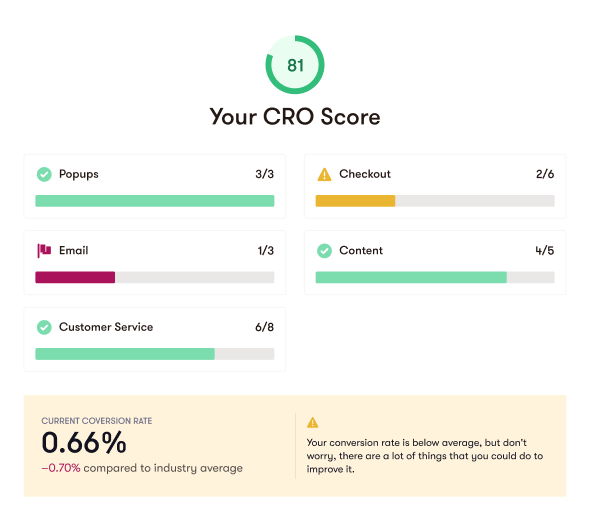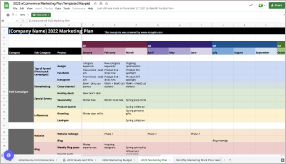
The Best Brand Strategy Tips For 2022
Building a strong brand strategy needs to be your first step. We offer reasons and ways for building a strong brand strategy using this secret formula.
DOWNLOAD TEMPLATELaunching a campaign without defining your brand strategy is like driving your car to an unknown location. You’ll probably spend a lot of energy, but you will arrive somewhere you didn't plan to end up.
Having defined brand values, a brand story, and messaging means you can navigate your campaigns to a clear destination. And usually, when you have a target and clear branding and marketing strategy, there’s a better chance that you will achieve it.
A good brand strategy will:
- Answer a true need of your target audience
- Differentiate your brand from other alternatives
- Authentically reflect your brand’s value
And, will ultimately help you be aligned with your business goals and KPIs.
So what is a branding strategy and how do you make one?
In this post, we break down every step of the brand strategy process.
And if you use these guidelines, there's no doubt that you will be able to create and implement an incredibly strong and valuable brand strategy and grow your business.
Let’s dive in.
[Add Banner Here]
Why is brand strategy so important?
Brand strategy is a long-term plan you create so that your business can successfully develop in order to achieve specific goals. A well-thought-through branding strategy affects all parts of your business and is directly related to your customer's needs, emotions, and competitors.
Your brand strategy is, in a lot of ways, your direction and path to success. Without a solid strategy, it will be impossible to know the story you are trying to spread. It will be impossible to know the values that your business represents.
And this has been proven by research, just look at these stats:
- 86% of consumers say that authenticity is a key factor when deciding what brands they like and support.
- 81% of consumers say that they need to trust a brand to buy from them.
- The consistent presentation of a brand increases revenue by 33%.
- 66% of consumers think that transparency is the most attractive quality in a brand.
- 62% of consumers want companies to stand up for the issues they are passionate about.
To summarize, consumers expect and reward brands for being authentic, trustworthy, and for picking a cause and being greater than just their product ie. having a “why”. But companies can sometimes get this wrong.
Here’s one of my favorite slides from the 2019 Edelman Report on brand values & trust. It talks about global brands that adopt a value but consumers see it as a marketing ploy. It’s called “trustwashing”.

Not to dwell on the negative but when you have no brand strategy...
- You don’t understand your purpose, vision, mission, or values and you don’t know how to communicate that to your prospects and customers.
- Your marketing plan is disjointed and all over the place, lacking structure and cohesiveness.
- Your content tends to be inconsistent at best and tends to confuse your audience (making it difficult to create an authentic omnichannel experience).
- Your team is fractured by confusion, conflict, and disunity. There are no resources that tell your team what kind of content & messaging to create and what it should look like.
- Your brand is not memorable and you have very low retention rates, little to no ambassadors, referrals, and customer loyalty.
- You don’t have anyone in charge of brand marketing or resources dedicated to developing your brand.
The bottom line is: take time and invest in building a strong brand strategy that’s both transparent, consistent, and inspires your customers to develop a lasting relationship with you.
And no, you don’t need to hire a fancy brand consultant and pay for an overpriced brand audit to be able to create a comprehensive brand strategy. You can start right here, right now.
How do you do that?
Here are 4 easy steps.
4 steps to creating a brand strategy
Your brand is your story, and stories have the power to change people's perceptions and realities. Your brand strategy is a reflection of your story. When people hear authentic stories, it usually connects them, in an emotional way, to your brand. It happens in B2C brands, and in B2B brands.
To figure out your brand story, and to help improve your strategy, we recommend you start by asking the following questions:
- Start with WHY - What is your brand’s vision? Why does the brand exist? Where does it aim?
- What is your value proposition? What are the different solutions your brand offers? How are they unique?
- What are your brand’s strengths? What are the values that led to your brand’s establishment?
- What are your brand’s weaknesses in the market and in the eyes of your customers?
Once you answer these questions, you're one step closer to building a powerful brand.
How to define your ‘why’
The “why” is the core of your brand and should be very clearly defined. It’s why you get up in the morning, it’s why you do what you do.
For example, here’s the process we took to define Mayple’s “why”.
When we started to design our brand story and brainstorm how to build the strategy, we opened our first sessions with a short TED talk from the hugely popular author and speaker Simon Sinek about the ‘Why’.
We started by thinking, why do we get up in the morning? What is the value we all wish to create by doing what we do? We went beyond thinking about the long-term success of our company.
We focused on the problem that we are solving for our customers. We succeeded to pinpoint the friction that our company solves: the digital marketing zero-sum game small and medium-sized businesses are struggling to win, without the tools to do so.
Imagine this: a business works so hard to create an awesome product or service. They work tirelessly to create a strong and impactful strategy. This business invests in digital marketing to spread the word and attract new customers.
It seems like it works for everyone else…
After a while, this business realizes that putting ads on Google, Facebook and Yelp doesn’t work like magic.
Getting results from digital marketing requires high professional abilities.
But, a small/medium business doesn’t have access to top-notch marketers like big brands have, to their advanced technology tools, and their huge digital marketing budgets. So they stay behind.
This business feels frustrated and angry, for what seems like the unfair bitter fate of small businesses. But then, the business feels the urge to break through, to be seen, and get recognition for what it does best.
This is what Mayple is about.
Empowering you to fulfill your full potential.
Talking to our customers and getting inside their heads and experiences was the effective part and helped tremendously when building our strategy.
To discover your brand’s WHY, try to list 2-4 main values that represent your brand promise. It’s easy to think of this list by remembering the story that led to the creation of the business. This is the reason you and your team are investing so much effort in building your brand strategy.
Align your brand with the customer
Answering the true needs of your target market is what makes your brand relevant and what motivates your potential customers to engage with it (make sure your brand strategy reflects and solves the needs of your target audience).
The most successful brands either communicated their customers’ most important values (for example, Coca-Cola, life & happiness) or solved their customers’ biggest pain points (for example Uber, move the way you want).
Research shows that 77% of consumers buy from brands that share the same values as they do. And if you think that’s just superficial look at this stat - meaningful brands outperform the stock market by 134%. Wow.
So brand values are super important, and aligning them with your ideal customers is even more important which is why you first need to understand what value your customers actually have.
To do this you should ask yourself the following questions:
- Who are my customers? Who could be the ideal customer segments to target for my growth?
- What’s important for my customers?
- List 3 functional benefits and 3 emotional benefits that your brand provides your customers.
- What are your customer's main barriers to buying your products or services?
- What do your customers say about your brand? What do they say about your competitors?
- What were the most effective marketing campaigns you performed? What made them successful?
To properly answer these questions, talk to customers, ask your sales team, or even try to call customers that were not pleased and left your brand.
Now list 2-4 values that are most important to your customers. It's important to remember that your most important value doesn't always need to be your core message, since it might just represent a basic value that doesn't create any differentiation.
“Values are things we do. Innovation is not a value, cause it’s not actionable. Instead, it should be ‘Look at the problem from a different angle’ because values have to be actionable” - Simon Sinek
Here’s a great video by Simon Sinek where he explains how a company should share its values.
If you answered all of the questions above, you probably have a few options for brand values to choose from. It is always good that a brand will have one leading value, and another 2-3 values to support it.
After putting it all together you will be set up to build your best strategy.
When building your strategy, you can never listen enough to what your customers have to say about your brand, about competitors, and especially, about what they expect and need.
After running a survey and interviewing some of our present and past customers, we could build a list of pain points that our customers experience while managing their digital marketing, and we also built a list of their expectations and the values that they represent. All of this information was vital to building the strategy.
This is what we came out with:
- Not knowing how to make the right choice about freelancer / digital agency
- Limited budget
- Frustrating replacements of unfitted marketers
- Mediocre results
- Lack of transparency
- Get their business voice heard
- Reach a bigger audience that will enjoy their value
- Be in control
- Feel confident
These were the values we identified: confidence & control, trust, hope, growth, be seen.
Create a positioning statement
A positioning statement is a short description of your product and target audience that explains what differentiates you from the competition. Positioning statements are internal documents that are never shared with the public and help companies improve their own brand consistency.
For example, Nike’s positioning statement is - “To bring inspiration and innovation to every athlete in the world.”
Analyze the competition
Identifying the opportunities and threats in the market is a basic step to communicating your brand and building your strategy. This information will allow you to create more relevant and smart messaging that will reflect your brand, ultimately helping you build a strong brand strategy.
In addition to that, you’d want to know the main messages and brand values your competitors communicate. When you map them, you can decide which messages are already overused and what the ‘free spots’ are that your brand can appropriate in a way that will differentiate it from other competing brands.
These are the questions we recommend you ask in order to understand your market and competition (and of course, in order to build the strongest strategy for your business):
- What are the market trends that have to do with your brand’s activity? What are the main challenges? What are the opportunities?
- Who are your brand’s main partners? What is their added value to your brand?
- Who are your direct competitors? Who keeps you up at night?
- What are their strengths?
- What are their main messages? What values do they represent?

Another great way to organize your competitive analysis is to try to build a table that compares your competitors messaging, according to value categories.
For example, if one competitor is saying: my product is simple to use, the other says: my product is easy to use, and the third one says: using my product is effortless, they all chose the ‘simple’ category and you should consider choosing a different value for your brand if you want to differentiate it.
Since we are a disruptor in our industry, defining who our competitors are was the first task. After doing that, we checked what they say to our potential customers, to make sure we are going to communicate our value in a different way, and to make sure that we build a unique strategy.
Fortunately, we saw that the marketing messages in the competitive environment focus on the service and rational factors. That left us with a wide territory for combining rational and emotional factors in our messaging and brand values and helped us build our strategy.

Now that you’ve written your brand values down, identified the ideal customer for your business, and analyzed the competition, it’s time to create your brand voice.
Create a brand voice
Building a brand voice is the way to build a consistent presence and brand personality for your business across your entire marketing funnel. So let’s define some terms and then see how it all comes together.
What is a brand?
A brand is an identifying symbol, mark, logo, name, word, and/or sentence that companies use to distinguish their product from others. A combination of one or more of those elements can be utilized to create a brand identity. Legal protection given to a brand name is called a trademark.
What is a brand voice?
A brand voice refers to the personality and emotion infused into a company’s communication. It’s how your brand comes across (or sounds) to a consumer via all your marketing channels.
It’s crucial to create a succinct idea of your brand voice in order for every member of the marketing team to be able to quickly adapt and create brand messaging that fits that voice.
There are a few ways to do that.
First, you can do the exercise of describing your brand voice in just three words. For example, let’s say your three broad traits are:
- Passionate
- Quirky
- Authentic
Now you can take each one and define it even further, to better clarify what each of these means to you.
- Passionate - enthusiastic, heartfelt, action-oriented, expressive
- Quirky - unexpected, contrarian, funny, irreverent
- Authentic - genuine, trustworthy, engaging, direct
Another way you could come up with your brand voice is to do the “We’re This, Not That” exercise. It’s like a process of elimination. Sometimes you can find out who you are by identifying what you are not.
So for example:
“We're funny, but not sarcastic”
“We’re frank, but not critical”
“We’re professional, but not too serious”
This is a really great way to narrow down exactly what your brand voice should be.
And once you do those two methods you can then put it all together into a brand voice chart. This is a chart that displays your voice characteristics, describes them, and then further defines them into Do’s and Dont’s.

Now that you have your brand voice defined you should look at the type of messaging and content you will be publishing. And that requires knowing the customer journey that your audience takes from discovery to purchase.
Understand the customer journey
How you come across needs to be consistent across all marketing channels but there are going to be nuances within each platform. So you need to find out exactly which platforms/channels your customers currently use to find you through and decide on the ones you really want to put more time and energy into.
Focus on the omnichannel experience
You’re going to want to communicate with customers through several channels as well as use multiple channels in your marketing campaigns. Research shows that marketers that use three or more channels in their campaigns earn 90% higher customer retention.

So if you focus on customer retention and long-term business growth then it’s best to think of the customer journey as a loop that feeds into itself, where your customers become brand ambassadors and start referring their friends to purchase your product.

Execute your branding strategy
Now that you have your strategy written out it’s time to execute it correctly across all of your channels. This part has a few key steps.
Create a visual identity
The visual identity (sometimes called a brand style guide) is the face of your brand. We’re talking - the logo, colors, typography, and any other visual content. Now that you’ve created your strategy it’s time to create the visual identity of your brand to really communicate your brand values and brand your voice visually.
Here’s an example of a brand visual guide from Medium:

Here’s an example of our own brand guidelines:

Communicate the strategy to the team
Last but not least, you need a really good team to execute your branding strategy. You need someone to create the strategy, a designer or a creative lead to create the visual guidelines, and then a marketing lead to make sure that every campaign and creative really matches the brand's voice and values.
Here’s a really great infographic from Column5 that shows this visually.

It’s important to get your entire team on board when you’re doing a brand redesign. You want to clearly communicate your brand’s objectives and positioning strategy to the key players in your organization.
If you’re a larger business then you should definitely involve the people that are in charge of managing teams and interfacing with your customers and various stakeholders.
You might want to create a role called a brand manager what Column5 calls a brand shepherd in that graphic above.
Brand managers are the point people for any questions on the brand and the visual identity of the company. They are in charge of defining the brand at the beginning of the process, then building your brand guidelines, and finally aligning the business goals with the brand.
Effective branding has to have a leader, someone who takes charge and ensures that there’s brand consistency in the long term.
Recap
Taking the time to build a successful brand strategy is one of the best things you can do to increase your revenue, retention, and long-term growth. Your one objective should be to create a memorable brand, one whose values resonate with your customers and drive them to become your biggest fans.
To make it easy to create your brand strategy check out our digital marketing plan template that creates a simple way for you to fill in and execute your brand strategy.
To recap, the steps you need to take are:
- Come up with your WHY
- Create a value proposition
- Do a SWOT analysis
- Align your brand with the customer
- Do competitor research
- Create a brand voice
- Understand the customer journey
- Create a brand identity
- Educate your team on the strategy
- Execute (it’s game time 🏈)
In our case, Mayple’s core value is empowerment. We aim to empower our customers and marketing experts so both will be able to fulfill their potential.
We also have three supporting values: professionalism, unbiased, and Maypling (which is a unique experience we give our customers).
You can see our brand story and values here.
What are your brand's core values? How are you going to build your brand strategy?
Feel free to reach out if you need help with any of this. We have a community of 600+ top marketers that can help you scale your business and reach your ROI goals. Also, if you need any help with your messaging or executing your strategy check out our marketing guides.
















